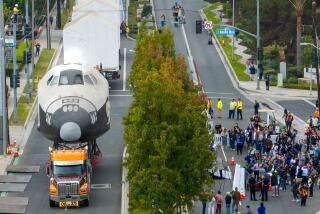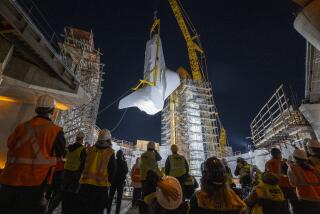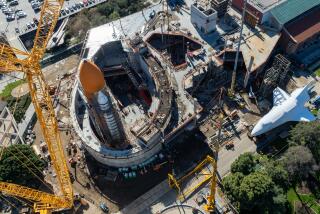Futuristic Craft Taking Shape in Palmdale
They don’t look like much, but the oddly shaped structures growing inside the cavernous Building 704 in Palmdale are the first pieces of a revolution in space. At least, that’s the hope.
For the last two years, Lockheed Martin and a team of contractors and NASA engineers have been working on the X-33, an experimental craft designed to test the feasibility of a single-stage reusable launch vehicle.
After 17 months of design, the building began. The X-33, funded with about $941 million in NASA money and more than $200 million from Lockheed, is about 8 1/2 months into its 19-month construction schedule. The first flight is set for July 1999.
The visible X-33 parts--various composite braces, the hulking liquid oxygen tank, the beginnings of the vehicle’s nose gear and other pieces--are the result of the combined efforts of eight Lockheed Martin units, eight NASA centers, four major contractor-partners, the Air Force and a handful of subcontractors, said Jerry Rising, Lockheed Martin’s vice president in charge of the X-33 program.
“We’re moving forward with real hardware and the vehicle is taking shape,” said Jack Gordon, president of Lockheed Martin’s Skunk Works in Palmdale. “This is high-risk, and it’ll be high payoff, not only for Lockheed Martin but also for the nation.”
Today, only the space shuttle is capable of traveling to space and returning safely for another trip. Workhorse rockets, such as the Titan, Atlas and Delta, all carry satellites into space but leave behind metal body parts as space junk--which makes satellite launching a costly endeavor.
The idea behind the X-33 is to build an unmanned vehicle that could be launched like a rocket and landed like a plane without the use of costly second-stage boosters.
If the X-33--a half-scale version of the vehicle--proves itself in a battery of tests and 15 flights, Lockheed Martin will proceed with building the real thing--a craft called the VentureStar.
VentureStar would be funded privately--at a cost of up to $5 billion for two vehicles and its space ports--and would be capable of carrying supplies to the International Space Station (once it’s built) as well as carrying commercial satellites into orbit.
NASA and Lockheed Martin say VentureStar could carry cargo at a cost of about $1,000 per pound contrasted with today’s cost-prohibitive $10,000-per-pound price.
“This is putting us on the verge of making a great leap in terms of access to space,” said Gene Austin, X-33 program manager at NASA.
For one, Austin said, the VentureStar would allow NASA to spend its money “on what we do in space, rather than on getting there.”
There are plenty of hurdles ahead, including a tight schedule.
The X-33’s first flight was initially set for next March but has been pushed to July. And difficulties are emerging in the construction of the vehicle’s hydrogen tanks and with the unique “linear aerospike” engines that are being built by Rocketdyne for the rocket.
Lockheed Martin must also select the sites for the VentureStar’s space ports. Last, there is the business plan and $5 billion worth of fund-raising.
More to Read
Sign up for Essential California
The most important California stories and recommendations in your inbox every morning.
You may occasionally receive promotional content from the Los Angeles Times.










